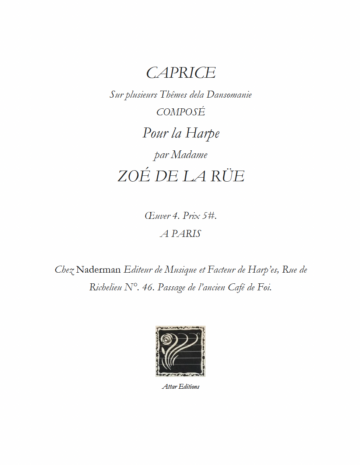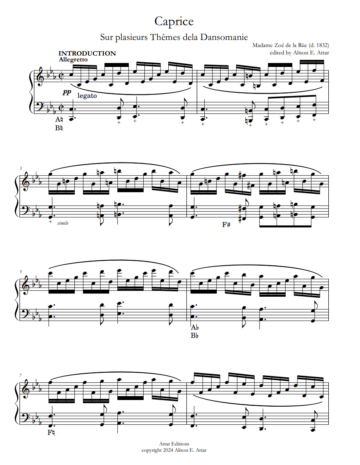Description
Note from the arranger
Madame Zoé de la Rüe (d. 1832) was a celebrated harpist and composer living in France around 1800. A student of pianist and composer Daniel Steibelt (1765–1823), her virtuosic writing for single-action pedal harp can be found in a number of published classical solo and chamber music compositions.
Zoé de la Rüe’s instrument, the single-action pedal harp, was invented around 1720, and was the dominant harp from about 1750-1810. These stunning, handcrafted harps were lightly strung and tuned at a lower pitch, typically A=415. The lighter tension resulted in a beautifully nuanced, responsive instrument that could be played quickly and lightly with ease, especially compared to a modern pedal harp. As a result, playing Zoé de la Rüe’s music presents real challenges for the modern harpist, and this virtuosic “Caprice” is no exception.
“Caprice sur plusieurs themes dela dansomanie” – A “Caprice” is a free form, lively piece of music. Someone who is capricious has sudden changes of mood. “On several themes of… dance mania!” La Dansomanie was a ballet choreographed by the great ballet dancer Pierre Gardel (1758-1840) with music by composer Étienne Nicolas Méhul (1785-1917). The ballet premiered in 1800 at the Paris Opera and was a huge success. It told the story of a gentleman who was so fanatical about dance that he insisted on his entire household being able to dance, including his daughter’s suitors. The ballet was immensely successful with audiences, who were looking for a whimsical distraction after the terror of the French Revolution. This was also the first ballet production of the Paris Opera that featured the bourgeois.
Zoé de la Rüe’s solo work based on themes from this ballet is lively and capricious, just as the title suggests. It demonstrates her absolutely mastery of the instrument, along with her wonderful sense of humor and showmanship. I have suggested pedalings and a few fingerings. Ornamentation is fully written out… Have I lost sleep regarding de la Rüe’s ornamentation? Why yes. Yes, I have. Music of the early 19th century begins to stray from the strict rules of ornamentation of the Baroque period. I have carefully considered every single ornament in this composition. Notation that appears as a grace note in this edition should be played lightly and before the beat. Any ornaments that are to be placed on the beat have been fully written out. Harpists playing from the printed version will want to add blank pages between 2-3, 9-10 and 16-17 to facilitate page turns.
Additional information
| Instrumentation | |
|---|---|
| Genre | |
| Composer | |
| Artist | |
| Level | |
| Harp Type | |
| Nationality |
Reviews (0)
Be the first to review “Caprice” Cancel reply
You must be logged in to post a review.
This site uses Akismet to reduce spam. Learn how your comment data is processed.








Reviews
There are no reviews yet.